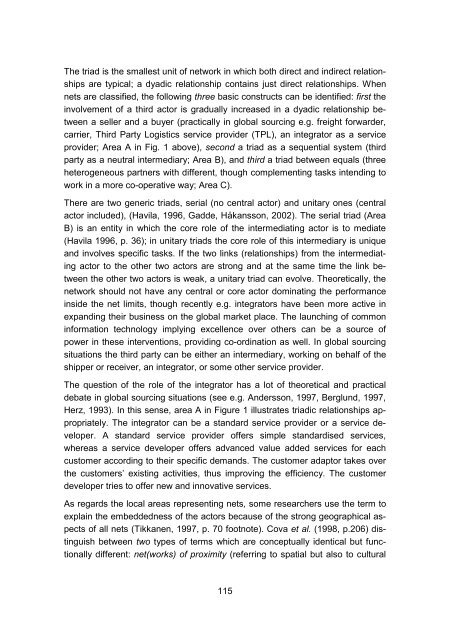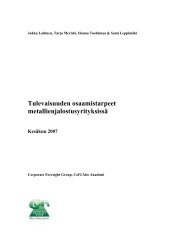849954 sisus
849954 sisus
849954 sisus
Create successful ePaper yourself
Turn your PDF publications into a flip-book with our unique Google optimized e-Paper software.
The triad is the smallest unit of network in which both direct and indirect relationships<br />
are typical; a dyadic relationship contains just direct relationships. When<br />
nets are classified, the following three basic constructs can be identified: first the<br />
involvement of a third actor is gradually increased in a dyadic relationship between<br />
a seller and a buyer (practically in global sourcing e.g. freight forwarder,<br />
carrier, Third Party Logistics service provider (TPL), an integrator as a service<br />
provider; Area A in Fig. 1 above), second a triad as a sequential system (third<br />
party as a neutral intermediary; Area B), and third a triad between equals (three<br />
heterogeneous partners with different, though complementing tasks intending to<br />
work in a more co-operative way; Area C).<br />
There are two generic triads, serial (no central actor) and unitary ones (central<br />
actor included), (Havila, 1996, Gadde, Håkansson, 2002). The serial triad (Area<br />
B) is an entity in which the core role of the intermediating actor is to mediate<br />
(Havila 1996, p. 36); in unitary triads the core role of this intermediary is unique<br />
and involves specific tasks. If the two links (relationships) from the intermediating<br />
actor to the other two actors are strong and at the same time the link between<br />
the other two actors is weak, a unitary triad can evolve. Theoretically, the<br />
network should not have any central or core actor dominating the performance<br />
inside the net limits, though recently e.g. integrators have been more active in<br />
expanding their business on the global market place. The launching of common<br />
information technology implying excellence over others can be a source of<br />
power in these interventions, providing co-ordination as well. In global sourcing<br />
situations the third party can be either an intermediary, working on behalf of the<br />
shipper or receiver, an integrator, or some other service provider.<br />
The question of the role of the integrator has a lot of theoretical and practical<br />
debate in global sourcing situations (see e.g. Andersson, 1997, Berglund, 1997,<br />
Herz, 1993). In this sense, area A in Figure 1 illustrates triadic relationships appropriately.<br />
The integrator can be a standard service provider or a service developer.<br />
A standard service provider offers simple standardised services,<br />
whereas a service developer offers advanced value added services for each<br />
customer according to their specific demands. The customer adaptor takes over<br />
the customers’ existing activities, thus improving the efficiency. The customer<br />
developer tries to offer new and innovative services.<br />
As regards the local areas representing nets, some researchers use the term to<br />
explain the embeddedness of the actors because of the strong geographical aspects<br />
of all nets (Tikkanen, 1997, p. 70 footnote). Cova et al. (1998, p.206) distinguish<br />
between two types of terms which are conceptually identical but functionally<br />
different: net(works) of proximity (referring to spatial but also to cultural<br />
115








